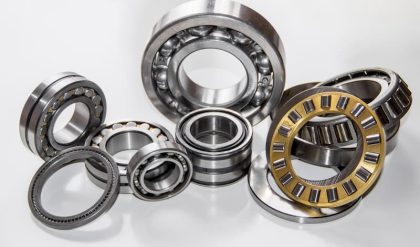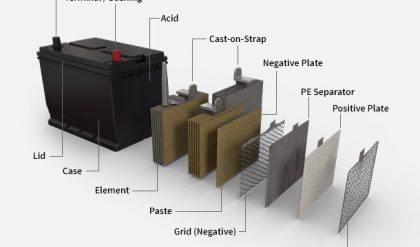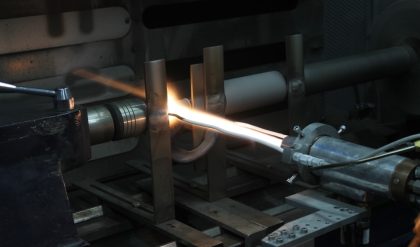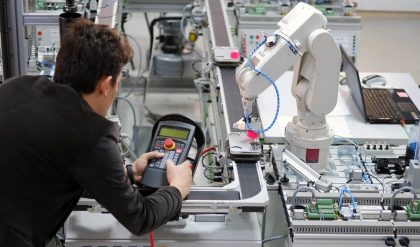Non-destructive testing (NDT) is a wide group of analysis techniques used in science and industry to evaluate the properties of a material, component or system without causing damage. Because NDT does not permanently alter the article being inspected, it is a highly-valuable technique that can save both money and time in product evaluation, troubleshooting, and research. Common NDT methods include ultrasonic, magnetic particle, liquid penetrant, radiographic, and eddy-current testing. Penetrant is used to check discontinuities i.e cracks, pits etc open to the surface on parts made of non porous materials. This method depends on the ability of the penetrant to enter into a surface discontinuity in the material to which it is applied. It is applicable to all solid non-porous material
Types
1. Fluorescent Penetrant inspection (fpi)
2. Magnetic particle inspection (mpi)
3. Ultrasonic
4. Eddy Current
5. X-ray
1. FLUORESCENT PENETRANT INSPECTION (FPI)
This is a method which can be employed for the detection of open to surface discontinuities in any industrial product which is made from a non porous material. This method is widely used for testing of nonmagnetic materials. In this method liquid penetrant is applied to the surface of the product for a certain predetermined time, after which the excess penetrant is removed from the surface. The surface is then dried and a developer is applied to it. The penetrant which remains in the discontinuity is absorbed by the developer to indicate the presence as well as the location, size and the nature of the discontinuity. Penetrants used in liquid penetrant are either visible dye penetrant or fluorescent dye penetrant. The inspection of the presence of indications dye visible by penetrant is made under white light while inspection of presence of indications by fluorescent dye penetrant is made under ultra violet (or black) light under darken condition. The liquid penetrant processes are further subdivided according to the method of washing of the specimen. The penetrants can be:
· Water washable.
· Post emulsifiable, i.e. an emulsifier is added to the excess penetrant or surface of the specimen to make it water washable, and
· Solvent removable, i.e. the excess penetrant is needed to be dissolved in a solvent to remove it from the Test Specimen surface.
Advantages
· Capable of examining all of the exterior surface of objects
· Capable of detecting very small surface discontinuitie
· Can be used on a wide variety of materials ferrous and non-ferrous
· Can be accomplished with relatively inexpensive non-sophisticated equipment
Types of penetrant
· Visible dye
· Fluorescent
· Dual mode(Visible dye & Fluorescent)
Steps involved in FP
1. Step 1 Cleanin
Removes oil, soil, moisture inside flaw or on part surface
2. Step 2 Penetrant Applicatio
Penetrant applied to the surface of the clean part. It is allowed to remain on the surface of the part surface for a period of time to allow it to enter and fill any openings or discontinuities open to the surface
3. Step 3 Washin
After a suitable dwell period , penetrant is removed from the part surface
4. Step 4 Dryin
The part is dried
5. Step 5 Develop
A material called developer is then applied. The developer aids in drawing any trapped penetrant from discontinuities and improves visibility of indications
6. Step 6 Inspection
This step involves visual inspection under appropriate lighting conditions
Function of Develop
The basic function of developers is to improve the visibility of the entrapped penetrant indication. The improvement in visibility is achieved through a number of mechanisms that includes the following
• Assists in extracting the entrapped penetrant from discontinuities
•Spread or disperse the extracted penetrant laterally on the surface thus increasing the apparent size of the indication
• Improve the contrast between the indication & background
Visual inspection (Lighting
When fluorescent materials are energized by ultraviolet radiations visible light is emitted. Visual inspection is one of the most common and most powerful means non-destructive testing. Visual testing requires adequate illumination of the test surface and proper eye-sight of the Inspector
2) MAGNETIC PARTICLE TESTIN
A process of non-destructive testing for detecting surface and sub-surface defects in magnetic retentive materials. The process uses externally applied magnetic field or the part is magnetized using; either AC or DC current passed through the part. With the principle of magnetic flux a leakage field is created at discontinuities i.e. (cracks, voids).The presence of a surface or sub surface flaw (void or crack) in the material allows the magnetic flux to leak at the flaw. This deformation of the magnetic field is not limited to the immediate locality of the defect but extends outside the part. The distance the leakage field extends to the surface and to the outside of the part into air relates to the strength of the magnetic field induced into the part. The amount of magnetism relates to the size of the part and amount of current AC or DC or externally applied magnetic field to magnetize the part. This allows different types of magnetic particles commonly Iron Oxide to gather at the leakage field.
A discontinuity which crosses the magnetic field creates north & south poles on either side of the defect area. When magnetic particles are applied to the part, the poles attract the particles and an indication of the discontinuity is formed. Mainly uses for detecting surface & sub surface discontinuities in ferromagnetic materials.
Magnetic particle inspection is a nondestructive testing method which can be used in the evaluation of all ferrous materials. Like other forms of nondestructive testing, this method has the advantage of not damaging or compromising the materials being tested during the testing process. This method is one of the fastest and least expensive ways to test ferrous materials before certifying them as safe and ready for use.
3) ULTRASONIC INSPECTION
This method uses ultrasound to detect internal discontinuities. it can be used to measure the overall thickness of the material and the specific depth of a defect. The term ultrasonic pertains to sound waves having a frequency greater than 20000 Hz. Ultrasonic vibrations are generated by applying high frequency electrical pulses to a transducer element (piezoelectric element) contained within a search unit. Ultrasonic energy is transmitted between the search unit & the test part through a coupling medium such as oil, grease
Ultrasonic testing is often performed on steel and other metals and alloys, though it canalso be used on concrete, wood and composites, albeit with less resolution. It is a formof non-destructive testing used in many industries including aerospace, automotive and other transportation sectors.
4) EDDY-CURRENT TESTING
Eddy-Current Testing is an electrical NDT method which can be used to detect and quantify surface breaking or near surface defects in materials, components and structures. It is a non-contact method, and can successfully test through good quality paint coatings etc. it is used to detect discontinuities in parts that are conductors of electricity. Eddy currents are electrical currents inducedin a conductor by a changing magnetic field. When eddy currents encounter an obstacle, such as crack the surroundings become distorted. The change is detected on a meter or other type of display
Principle of Operation
A coil energized by an AC current is placed in close proximity to the test specimen (which must be an electrically conducting material). The current inthe coil generates a magnetic field which induces currents to flow in the specimen. These currents (the “eddy-currents”) generate their own magnetic field, which interacts with the original field.
Changes in the field, due to the presence of defects etc, cause changes to the coil’s impedance which are displayed on the screen of the eddy-current flaw detector instrument
5) RADIO-GRAPHIC TESTING (X-RAY INSPECTION)
Radiography (x-ray) is an NDI method used to inspect material and components, using the concept of differential adsorption of penetrating radiation. A material discontinuity such as void or change in configuration changes the effective thickness of a material and thus changes the degree of radiation absorption. Each specimen under evaluation will have differences in density, thickness, shapes, sizes, or absorption characteristics, thus absorbing different amounts of radiation. The unabsorbed radiation that passes through the part is recorded on film, fluorescent screens, or other radiation monitors. Indications of internal and external conditions will appear as variants of black/white/gray contrast
on exposed film, or variants of color on fluorescent screens.
The radiographic testing method is used for the detection of internal flaws in many different materials and configurations. An appropriate radiographic film is placed behind the test specimen and is exposed by passing either X-rays or gamma rays (Co-60& Ir-192 radioisotopes) through it. The intensity of the X-rays or gamma rays while passing through the product is modified according to the internal structure of the specimen and thus the exposed film, after processing, reveals the shadow picture, known as a radiograph, of the product. It is then interpreted to obtain data about the flaws present in the specimen. This method is used on wide variety of product such as forging, casting and weldments
X & gamma radiographic inspection uses the penetrating abilities of electromagnetic radiations to examine the interior of objects.
Limitations
Compared to other nondestructive methods of inspection, radiography is expensive. Relatively large costs and space allocations are required for a radiographic laboratory. Costs can be reduced considerably when portable x-ray or gamma-ray sources are used in film radiography and space is required only for film processing and interpretation. Operating costs can be high because sometimes as much as 60 percent of the total inspection time is spent in setting up for radiography. With real-time radiography, operating costs are usually much lower, because setup times are shorter and there are no extra costs for processing or interpretation of film.






Comments are closed.